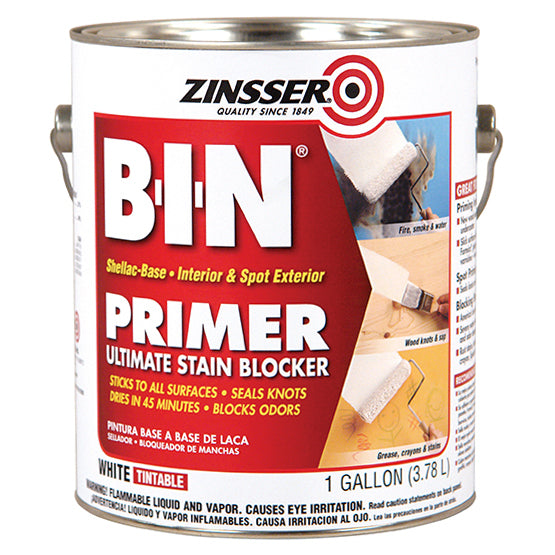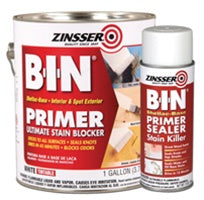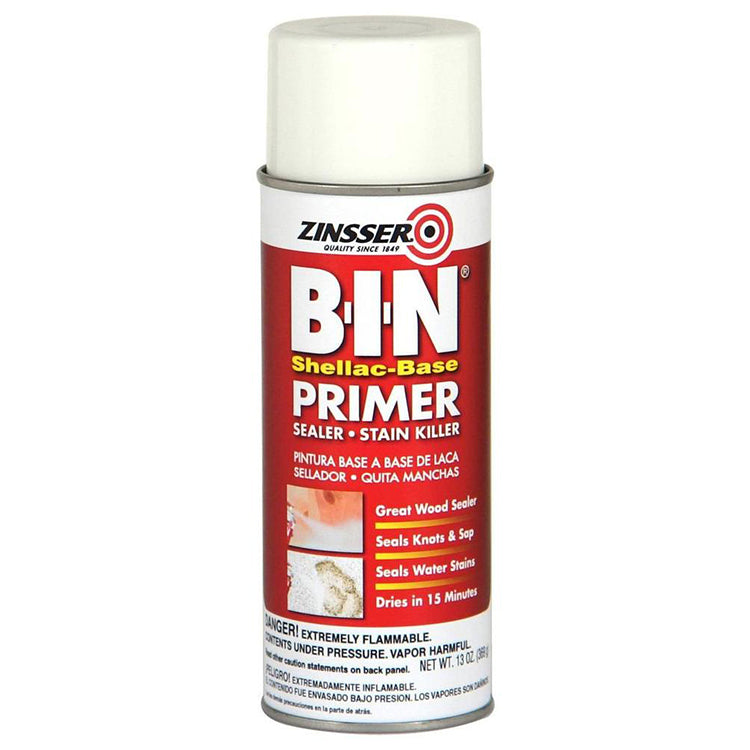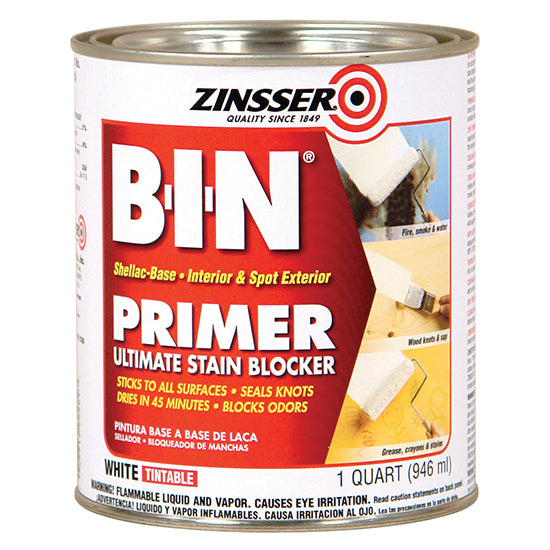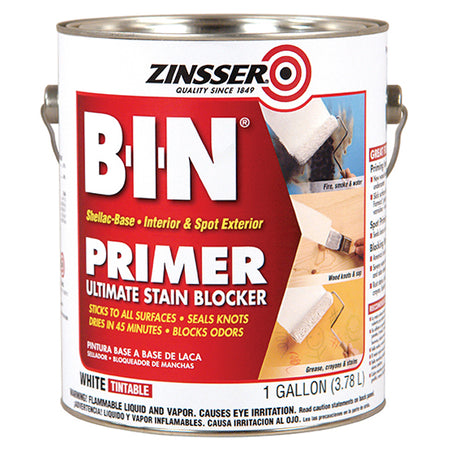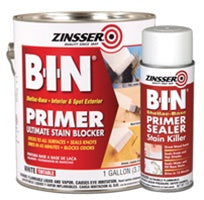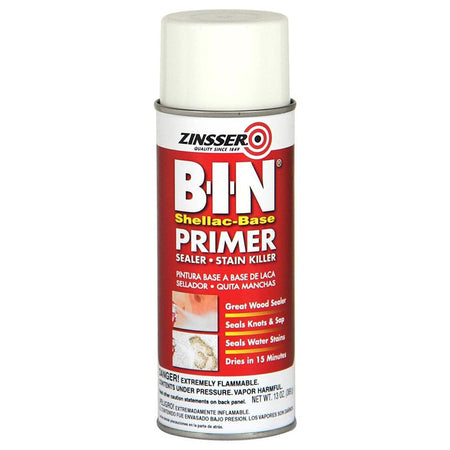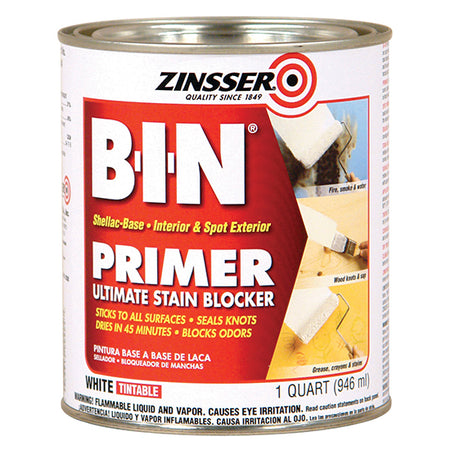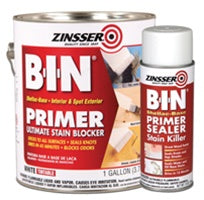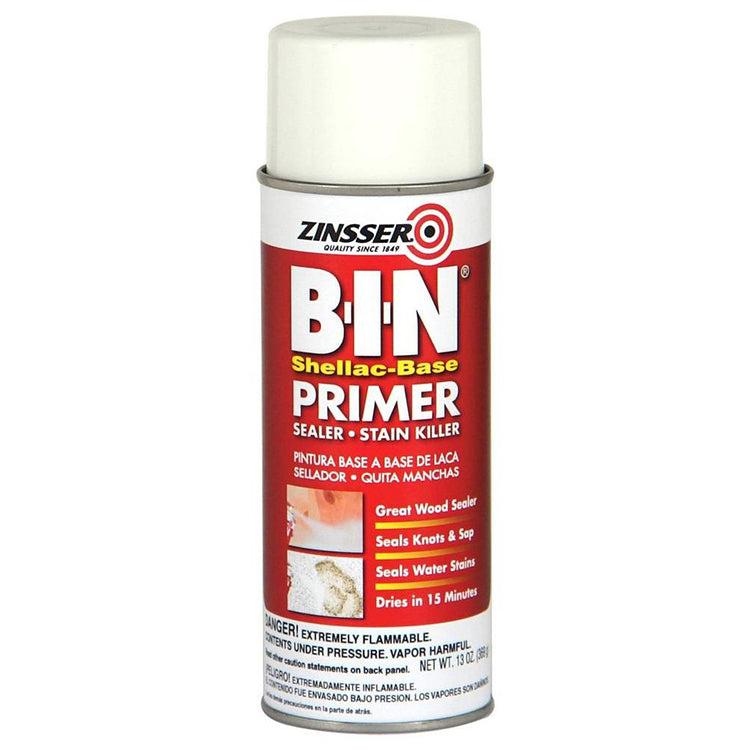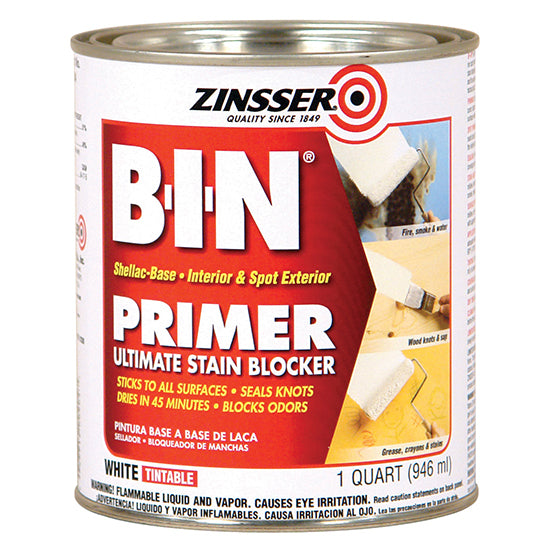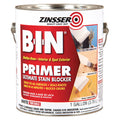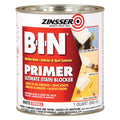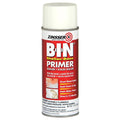INTERIOR
Apply to new and previously painted drywall, plaster, wood
(pine, fir, cedar, redwood, plywood), metal (aluminum,
stainless steel, galvanized metal), vinyl, PVC, fiberglass
and masonry (stucco, concrete block, concrete, brick).
For exterior surfaces, apply to new or previously painted wood
(pine, fir, Cedar, Redwood, T-111, plywood, pressure-treated wood),
hard board, glass, metal (aluminum, stainless steel galvanized
metal), PVC, rigid plastics, aluminum and vinyl siding, fiberglass
and masonry (stucco, concrete block, concrete, brick).
Blocks stains and odors resulting from water & fire damage,
seals stains from dark colors, grease, rust, creosote, asphalt, crayon,
lipstick, graffiti, markers, knots, sap streaks, tannin bleed,etc.
EXTERIOR
Use B-I-N Shellac-Base Primer to spot prime persistent
bleed from knots and sap streaks before full surface priming with a
water-based or oil-based primer.
SEALING
B-I-N seals unpainted or porous surfaces so topcoat
paints have better coverage. It fills and binds wood fibers
to create a smooth, sealed surface with “enamel holdout”
so fewer coats of paint are needed. Very porous surfaces
may require two coats which may reduce the square foot
coverage of the product.
STAIN BLOCKING
B-I-N is an excellent interior stain killing primer. One coat
effectively blocks stains, including water, nicotine, ink,
crayon, marker, rust and smoke stains so they will not
bleed into the topcoat. Some stains require a second coat.
B-I-N is recommended for permanently sealing heavy
fire and water stains and odors caused by fires. It also
seals in urine and other animal odors and is recommended
for sealing nicotine stains and odors from tobacco.
SURFACE PREPARATION
Surfaces should be clean, dry, sound and free of dust, dirt,
excessive chalky material,grime, grease, oil, wax, mildew,
wallpaper adhesive, or any contamination that may
interfere with adhesion. If unsure of cleanliness, always
wash surface with household ammonia and water solution,
appropriate cleaning solution or solvent (do not use TSP
as a cleaner). Remove any peeling and/or unsound
coatings. Sand any remaining paint film edges smooth
with the surface. Remove existing stains by washing,
sanding, scraping, etc. Countersink exposed nail heads,
spot prime and fill all nail holes and gouges with Ready-Patch®
spackling compound or equally suitable material.
Lightly sand exposed exterior wood with 80 to 100 grit
sandpaper to remove loose or weathered wood fibers.
WARNING!
If you scrape, sand or remove old paint, you
may release lead dust. LEAD IS TOXIC. EXPOSURE TO
LEAD DUST CAN CAUSE SERIOUS ILLNESS, SUCH AS
BRAIN DAMAGE, ESPECIALLY IN CHILDREN.
PREGNANT WOMEN SHOULD ALSO AVOID
EXPOSURE. Wear a NIOSH-Approved respirator to
control lead exposure. Clean up carefully with a HEPA
vacuum and a wet mop. Before you start, find out how to
protect yourself and your family by contacting the National
Lead Information Hotline at 1-800-424-LEAD or log on to
www.epa.gov/lead.
PLASTER & CONCRETE
New plaster must age 30 days before application of
B-I-N Shellac-Base Primer. Concrete, plaster, masonry and
related surfaces must be fully cured before priming.
DAMAGED DRYWALL
Damaged drywall should be repaired prior to priming. Spot
prime area of torn drywall facing paper or exposed
gypsum core with GardZ® Problem Surface Sealer and
then skim coat with drywall mud before priming the total
area with B-I-N Shellac-Base Primer.
MOLD & MILDEW
Kill exterior mildew with Zinsser® JOMAX® House Cleaner
and Mildew Killer. Remove interior mildew stains by
washing the surface with a solution of one cup household
bleach in a gallon of water. Rinse well. Always wear
protective clothing and goggles to prevent eye and skin
contact with bleach. Do not add ammonia or other
cleaning products to the bleach solution. If concerned
about mold and mildew behind walls, underneath flooring,
in ventilation systems or other unseen areas, contact a
professional who specializes in mold and mildew
remediation. For commercial buildings and schools, follow
appropriate guidelines for mold removal.
WOOD
Bare wood that has been exposed for more than 4 weeks
should be lightly sanded with 80-100 grit sandpaper to
remove loose or weathered wood fibers. For new Cedar
and Redwood applications, allow B-I-N Shellac-Base Primer
to dry 24 hours before painting or topcoating. Sand
interior bare wood surfaces using medium to fine grit
sandpaper.
LIMITATIONS
B-I-N Shellac-Base Primer is not recommended for whole
surface exterior application or for application to
floors, decks, or any surface subject to immersion or prolonged
contact with water.
APPLICATION
Apply only when air, material, and surface temperatures
are between 0 and90ºF (-18 and32ºC) and the relative
humidity s below 70%. Do not apply B-I-N if surface
temperature is within 15°F of the dew point. Substrate
moisture should not exceed 12%. Do not thin. Thoroughly
mix to ensure any settled pigment is re-dispersed before using.
In most cases only one coat is necessary to prime most surfaces.
If excessive absorption occurs over very
porous substrates a second coat may be necessary.
Spot priming is recommended only under high-hiding topcoat
finishes. For best results, prime entire surface before painting.
Keep container closed when not in use. Apply with a
natural or synthetic (nylon, polyester or blend)
bristle brush, roller, or airless sprayer. Follow
manufacturer's instructions when using spray equipment.
For airless spraying use a 0.011"-0.013” tip at 800 to
1200 psi. If a conventional sprayer is used, spray at 45-55 psi.
Wear NIOSH approved respirator and provide adequate
ventilation.
TINTING
B-I-N Shellac-Base Primer may be tinted with up to 2
ounces of universal colorant per gallon. Tinting the primer
toward the color of the topcoat helps hide in one coat.
Note: The addition of universal colorant may prolong the
dry time of this product.
DRY TIME
Dries to the touch in 20 minutes, can be recoated in
45 minutes. The primer film develops full adhesion and
hardness after it cures in 1 to 3 days. Lower temperatures,
higher humidity, and the addition of tint will prolong dry
and cure time. Allow more time at cooler temperatures.
CLEAN-UP
Clean up spills and paint drips with denatured alcohol or
ammoniated detergent. If spills or drips have dried, use
denatured alcohol or ammoniated detergent to soften and
remove primer. Wash application tools in a solution of 1
part ammonia and 3 parts water immediately after use.
If product has dried on application tools, soak tools
overnight in a solution of equal parts ammonia and water.
Scrub clean with a stiff brush. Follow equipment
manufacturer’s directions to clean spray equipment.
Dispose of unused or unwanted product in accordance
with local laws regulating water-based coatings.
Practical coverage - Approximately 500 sq.ft./gal.
(12.3m2/l) depending on application method
and surface porosity.

